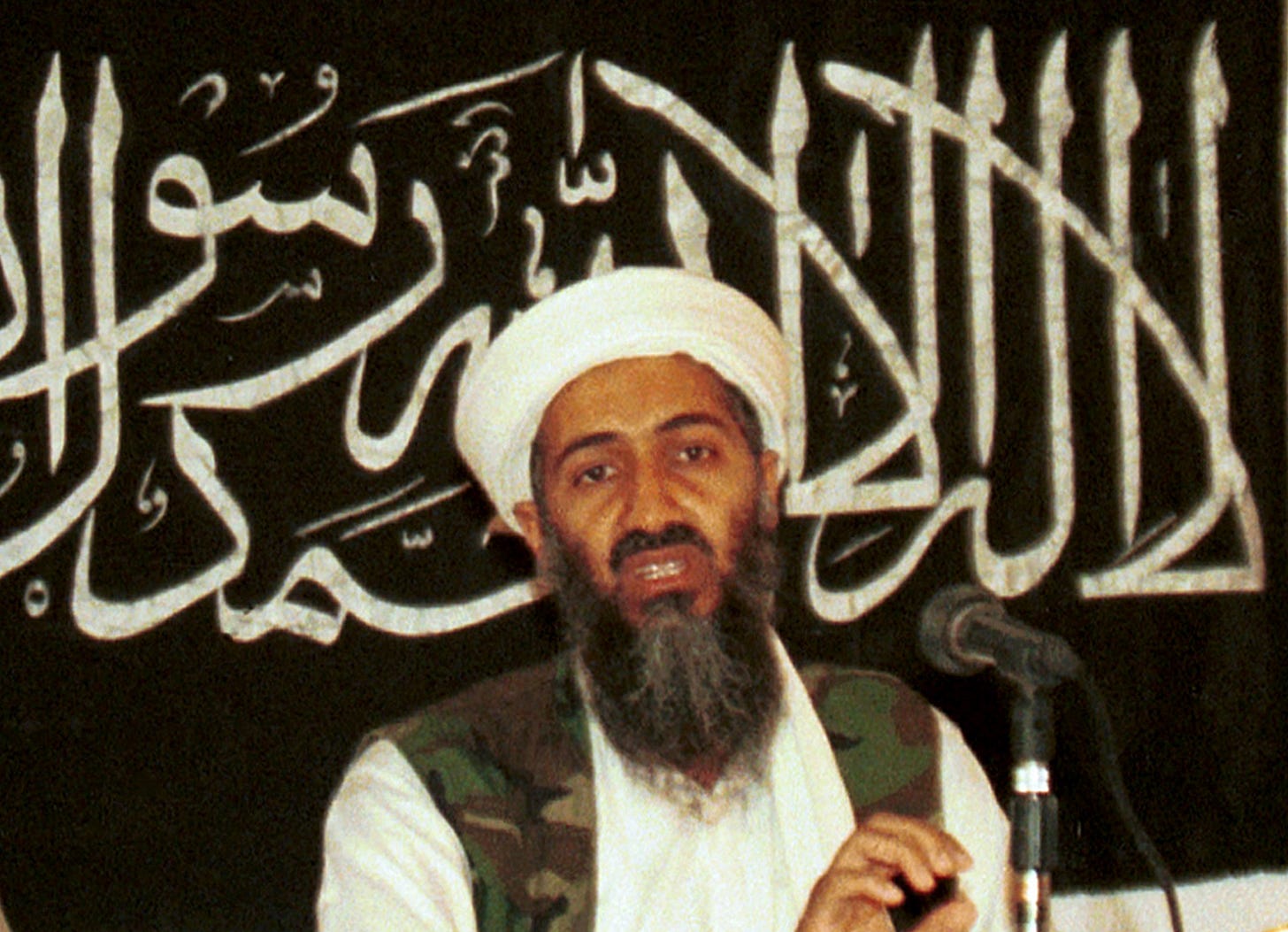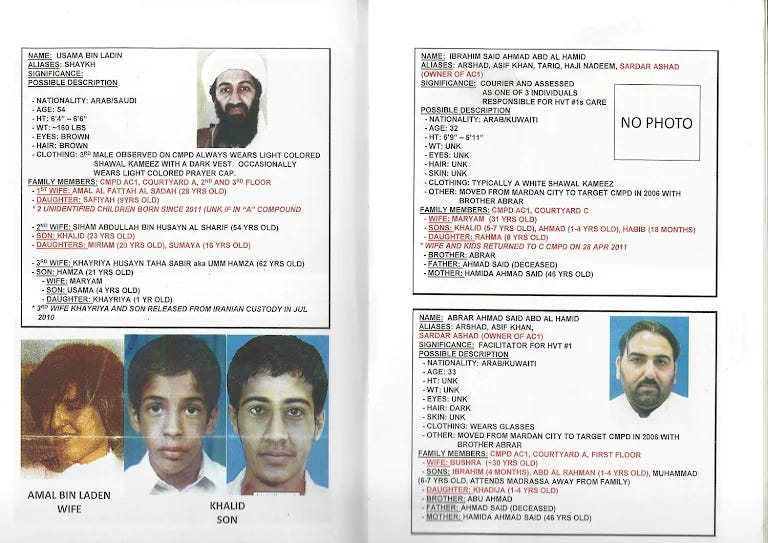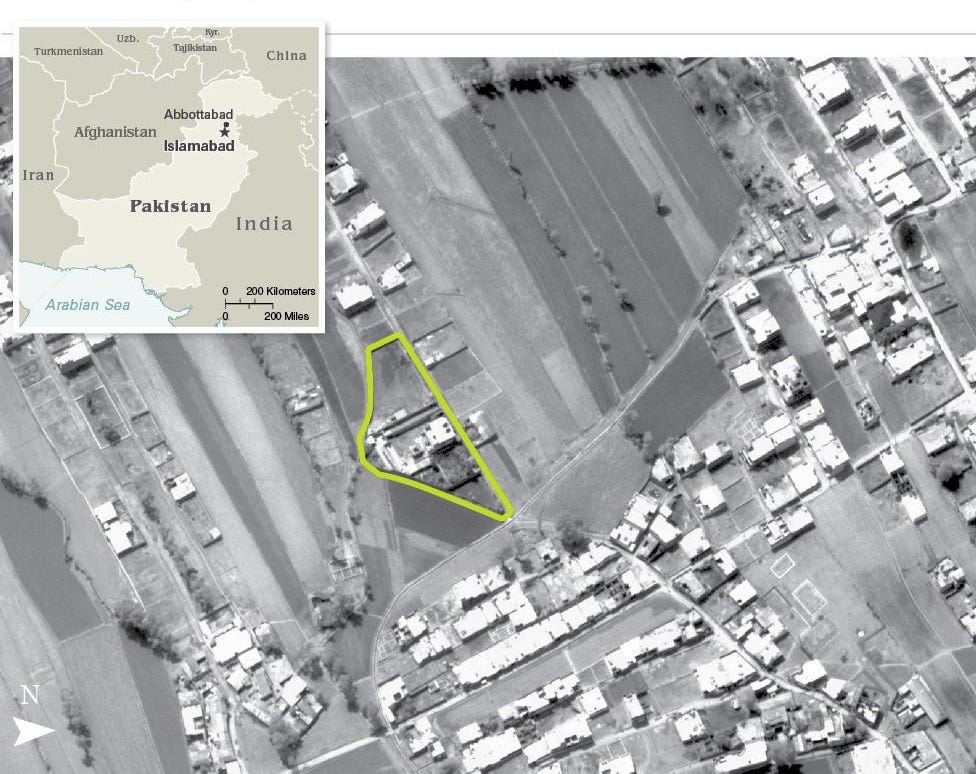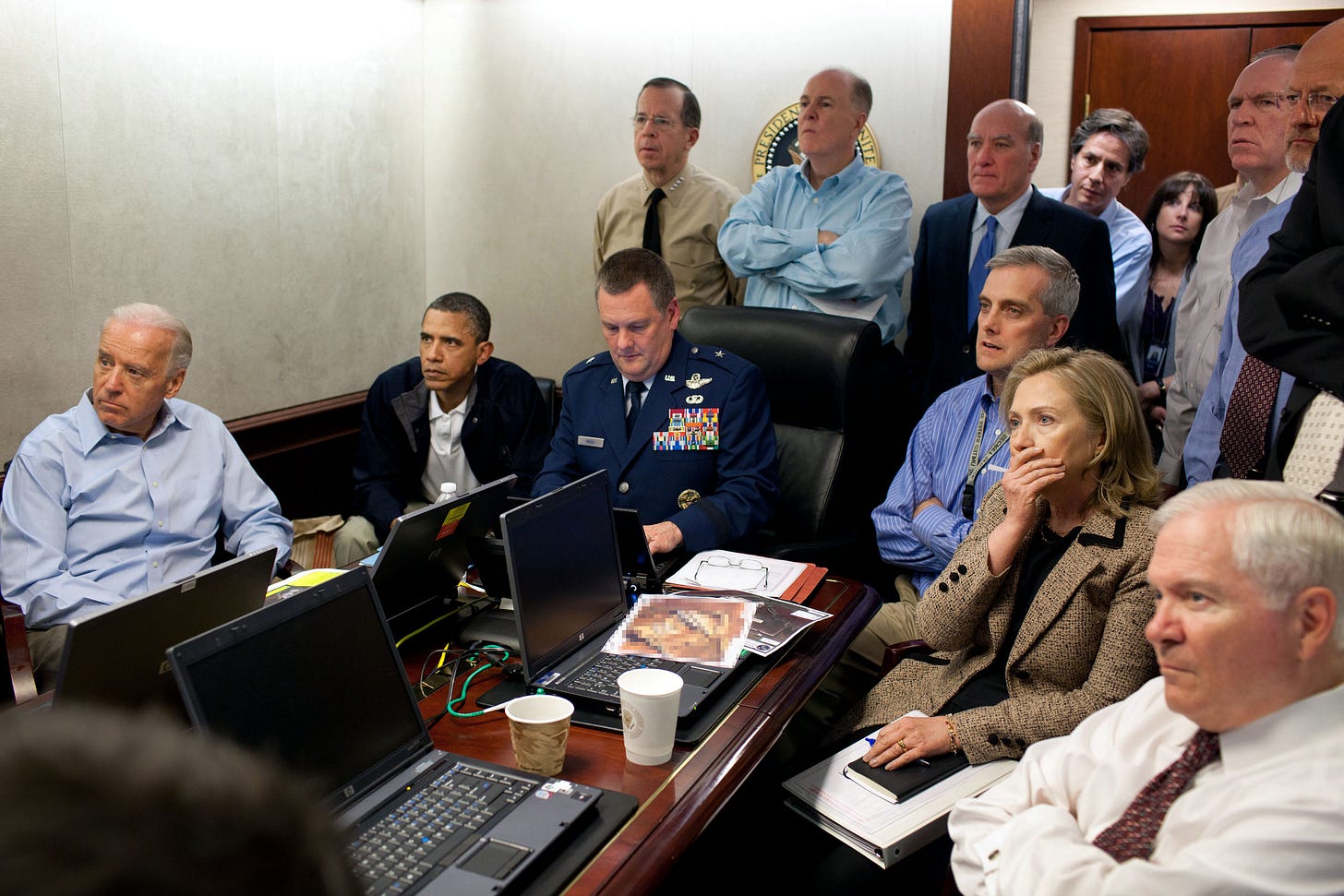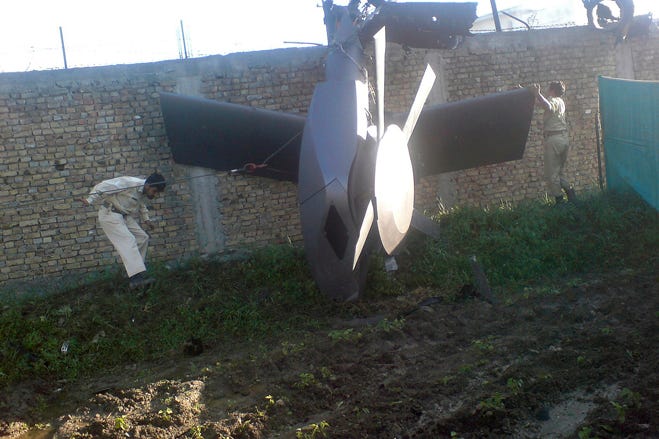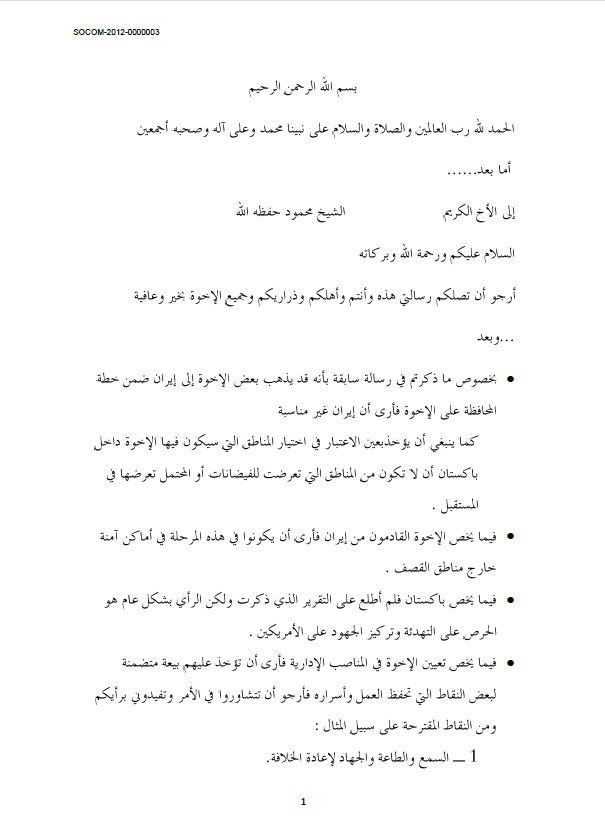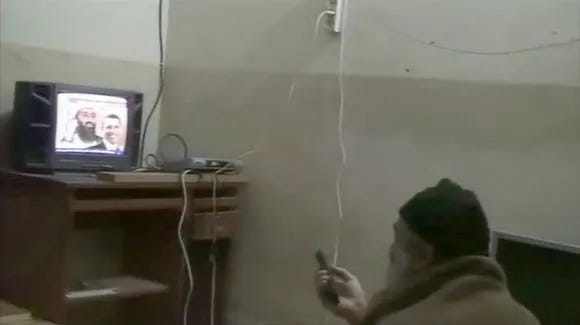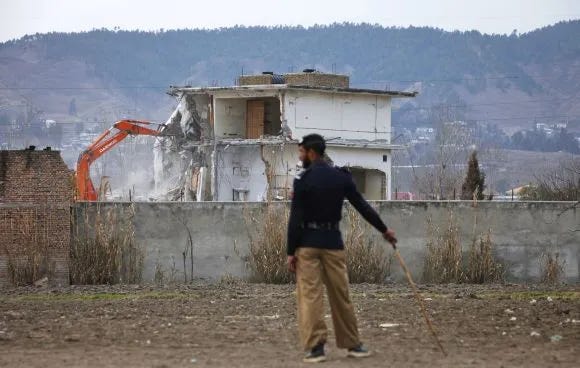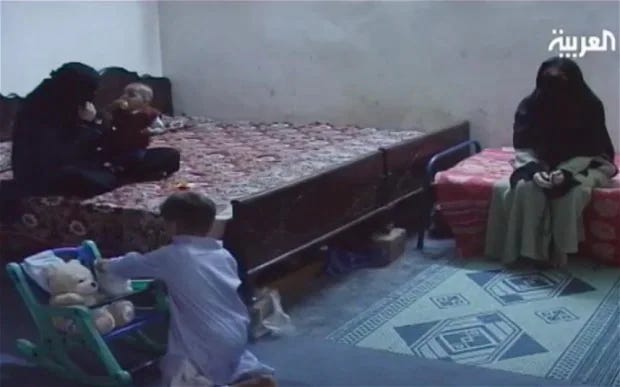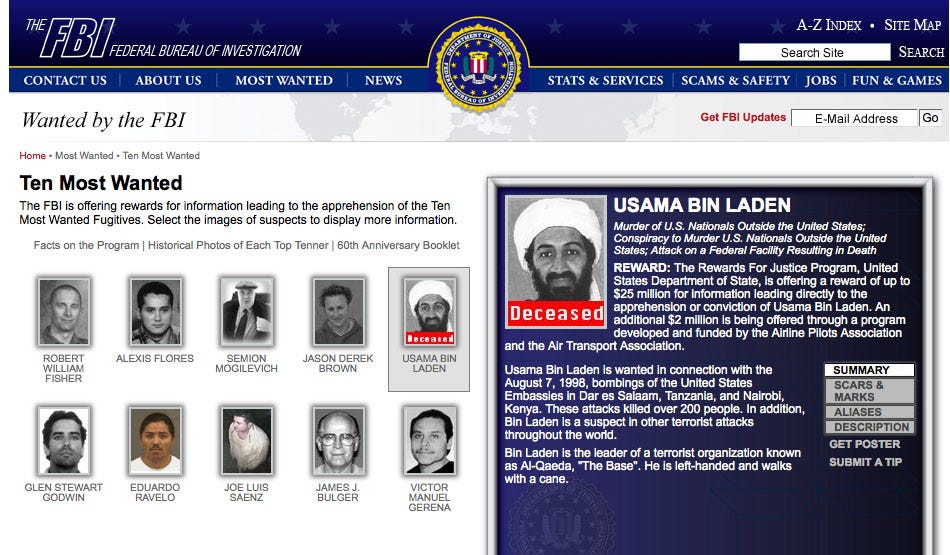The Intelligence that Killed Usama Bin Laden
State Sanctioned Torture, Electronic Surveillance, Fake Vaccines, and Pakistani Collusion
Bottom Line Up Front (BLUF)
This report provides a comprehensive overview of the decade-long hunt for Usama bin Laden (UBL), culminating in Operation Neptune Spear on May 2, 2011. The operation represented the culmination of a decade-long intelligence operation a fusion of multiple intelligence disciplines, tradecraft methodologies, inter-agency collaboration, foreign assistance, and covert execution, resulting in the assassination of al-Qaeda's founder in Abbottabad, Pakistan. However, evidence suggests that, while enhanced interrogation and ELINT provided preliminary intelligence — a brigadier (r) walk-in may have provided critical intelligence. While the Pakistani government officially denied awareness of bin Laden’s presence, multiple sources — suggest that elements within Pakistan’s Inter-Services Intelligence (ISI) directly involved in providing sanctuary to bin Laden from 2002 until his death in 2011. America’s goal was to launch a special operation eliminating UBL — gathering information to ensure positive identification (PID) — and then deny the operation claiming drone strike. Thereby, leaving Pakistani military out of the equation. However, a crashed helicopter during the extrajudicial killing lead to a last minute change of narrative and the ISI was subject to severe public scrutiny.
Official Narrative
The White House press corps was told in a briefing shortly after Obama’s announcement that the death of bin Laden was ‘the culmination of years of careful and highly advanced intelligence work’ that focused on tracking a group of couriers. Following the September 11, 2001 attacks, bin Laden became the primary target of U.S. counterterrorism efforts. Early attempts to capture bin Laden, including the Battle of Tora Bora (late 2001), were unsuccessful. Intelligence officials recognized bin Laden had ceased electronic communications after the 1998 U.S. missile strikes, necessitating focus on his human intelligence methods (HUMINT), particularly “enhanced interrogation” techniques (EIT).
Effectiveness of torture
While the CIA has long maintained that EITs, which include methods like waterboarding, sleep deprivation, stress positions, use of animals and insects, humiliation, rectal feeding tubes, mock burials, ice baths and threats to rape or murder family members, were instrumental in gathering intelligence that led to UBL. Conversely, the Senate Intelligence Committee’s 2014 report, based on a detailed review of CIA documents, concluded that torture did not provide crucial evidence and that key information was obtained through standard interrogation and other means. In aggregate 12 detainees provided courier info, 5 provided info before CIA custody, 9 subjected to EIT, 5 of 9 provided info before EITs, of remaining 4, 3 provided fabricated info post-EITs.
Mohammed al-Qahtani: underwent 48 days of interrogation (Nov 2002-Jan 2003), providing insights into al-Qaeda's structure
Hassan Ghul (captured 2004) identified a trusted courier who was close to Abu Faraj al-Libi, al-Qaeda's operational commander, notably identified al-Kuwaiti (the courier) as a critical courier the day before being subjected to unspecified interrogation techniques at a secret CIA "black site" in Poland
Khalid Sheikh Mohammed (captured 2003) initially minimized the courier's role but provided details under interrogation. Former Attorney General Mukasey said that the waterboarding of Khalid Sheikh Mohammed caused him to reveal the nickname of bin Laden's courier. The senate report disagrees, KSM, waterboarded 183 times across 15 sessions (an average of 12 waterboardings per session), did not provide significant information about al-Kuwaiti under EITs.
Abu Faraj al-Libi (captured 2005) denied knowing the courier, made up a name for the courier and denied knowing al-Kuwaiti, which paradoxically increased the courier's perceived importance
Ammar al-Baluchi: after being subjected to EITs, first revealed al-Kuwaiti as a courier, as noted in a footnote on page 414 of the Senate report The Senate Intelligence Committee Report on the CIA’s Detention and Interrogation Program.
It is an inconvenient truth that torture does on occasion lead to actionable intelligence, however most academic analysis suggests mixed results in aggregate, from the Spanish Inquisition (1575–1610) demonstrating 29% success, Philippine War (1899–1902) with 67% success, and Iraq under Saddam Hussein (1979-2003) demonstrated 39% success. In this case, evidence indicates that IC first learned about the courier's nom de guerre in 2002 from a detainee not in CIA custody. Enhanced Interrogations of detainees (e.g., Khalid Sheikh Mohammed, Abu Faraj al-Libi) allegedly revealed the existence of a trusted courier, Abu Ahmed al-Kuwaiti, though initial details were incomplete or misleading. The effectiveness of EIT later mythologized in Hollywood movies like Zero Dark Thirty.
Electronic Intelligence
Regardless of the exact elicitation methods used, by 2007, U.S. intelligence identified the courier's real name: Ibrahim Saeed Ahmed (aka Abu Ahmed al-Kuwaiti). In 2009, a team of CIA and NSA analysts tracked calls to relatives in the Persian Gulf establishing that al-Kuwaiti resided in Abbottabad, Pakistan. However the exact location was not known, as he turned off his mobile phone and removed its battery well before approaching the compound, only reactivating it after leaving the area. This practice prevented real-time tracking to the exact location. However, In mid-2010 the NSA intercepted another al-Kuwaiti call to a known al-Qaeda associate suggesting that he was back with high ranking leadership. As a result a small team of Pakistani’s (allegedly Lt. Col. Eqbal Saeed Khan of ISI through a Islamabad based private security firm intermediary) working for the CIA to physically track al-Kuwaiti from Pashewar to the Abbottabad compound.
The Insider
Some reports suggests that the above was a post hoc cover to protect the real source – a retired Brigadier and ISI intelligence officer identified by some as Usman Khalid. According some accounts, in August 2010, a former senior Pakistani intelligence officer approached CIA Station Chief Jonathan Bank at the U.S. Embassy in Islamabad, offering actionable intelligence on Usama bin Laden’s location in exchange for the $25 million reward and protection for his family. After passing a polygraph test, the informant claimed that bin Laden had resided undetected from 2001 to 2006 in the Hindu Kush mountains with some of his wives and children, and that the Inter-Services Intelligence (ISI) had located him by bribing local tribal members. The Pakistani military leadership, including General Ashfaq Parvez Kayani and ISI Director General Ahmad Shuja Pasha, consistently denied knowledge of bin Laden’s whereabouts. However, the informant alleged that the ISI had been harboring bin Laden under house arrest in Abbottabad, with financial support from Saudi Arabia. He further asserted that bin Laden was seriously ill and that the ISI had relocated Dr. Amir Aziz, a Pakistani army major, to Abbottabad to provide medical care. Despite public denials from Pakistani officials regarding Dr. Aziz’s involvement, sources indicated he received a portion of the U.S. reward after DNA evidence confirmed bin Laden’s presence in Abbottabad.
Surveillance.
By September 2010, intelligence had culminated in identifying the million dollar compound was “custom built to hide someone of significance.” Congress approved funding for a surveillance operation in December 2010, allocating tens of millions of dollars. The CIA established a covert safe house in Abbottabad for direct surveillance of the compound, noting the residents isolationist behaviours, the cost of the compound, and unusual security precautions. The forward observation base was allegedly staffed with Pakistani employees and foreign nationals
SIGINT: Signals intelligence, or lack thereof, revealed the compound lacked telephone and internet connections, an anomaly for an upper-class residence
HUMINT (local informants) confirmed the compound’s security measures and the presence of a tall (6'4") middle aged man (54 years old) nicknamed “pacer” or “walker” in the courtyard (later identified as bin Laden) who never left the premises.
GEOINT (satellite/drone imagery) National Reconnaissance Office conducted over 387 high-resolution and infrared satellite imaging sessions. RQ-170 stealth drones provided overhead imagery critical for mapping the compound National Geospatial-Intelligence Agency (NGA) created 3D renderings of the compound.
These sources contributed to a pattern of life analysis off the high-value target and a comprehensive intelligence picture of the compound, known locally as "Waziristan Haveli." The official line is that red-teaming other high-value targets (e.g., Ayman al-Zawahiri) but found no one else fit as well. However, the full methodology has never been publicly disclosed to protect sources and methods.
The Vaccine
In January and April 2011, to corroborate this intelligence, the CIA enlisted Dr. Shakil Afridi to conduct a fake hepatitis B vaccination campaign in Abbottabad’s Bilal Town, aiming to collect DNA from residents within the suspected compound. It was reportedly hoped that bin Laden's children would come forward and be identified by their DNA. However, officially the operation did not yield definitive DNA evidence; Afridi attempted to vaccinate residents at the compound but were denied entry, it reportedly helped lead to the identification of a phone number linked to bin Laden’s courier, Abu Ahmed al-Kuwaiti – who had already been linked to the compound in mid-2010. The CIA’s use of a medical campaign for intelligence purposes drew significant criticism from global health organizations, including Médecins Sans Frontières, and has been linked to increased vaccine hesitancy and attacks on health workers in Pakistan, thereby undermining public health initiatives such as polio eradication. Following the May 2011 U.S. Navy SEAL raid that resulted in bin Laden’s death, Dr. Afridi was arrested by Pakistani authorities and, in May 2012, sentenced to 33 years in prison for treason under the Frontier Crimes Regulation. The doctor was eventually tried under a tribal judicial system that denies the accused the right to have an attorney or to present evidence.
The Compound
Abbottabad is a popular holiday spot full of houses rented on short leases located just 1300 meters from the Pakistan Military Academy (PMA), a premier military training institution and 4 km from Abbottabad’s city center. The "Waziristan Haveli" was built in 2004-2006 in Bilal Town, Abbottabad, Pakistan it was a large, fortified compound (3,500 square meters, 8x larger than nearby houses) with 3.7–5.5-meter walls, barbed wire, no Internet or landline. Three-story main structure with third-floor balcony featuring a privacy wall. The compound build for Usama had an estimated value of the property was $1 million. They took security precautions like living in total isolation from neighbours with minimal outside contact and burned refuse rather than placing it for collection, all highly unusual for an urban residential area. However, the compound was not an armed enclave. For nearly eight years, he relied on just two trusted Pakistanis, whom American investigators described as a courier and his brother. Bin Laden lived with his youngest wife, Ibrahim Saeed Ahmed (al-Kuwaiti) and his brother Abrar managed the property Compound housed multiple family members and supporters; This included four adult males, five or six adult women, and nearly 20 children. Bin Laden had reportedly lived there for at least five years before the raid.
Strategic Planning
By August 2010, President Obama was briefed on the compound. Intelligence agencies assessed there was a 60–80% likelihood Bin Laden was there. President Obama's national security team deliberated between bombardment, precision airstrike and direct action options. However, with risk assessments acknowledging substantial uncertainties regarding bin Laden's presence including the absence of pre-raid photographic confirmation or voice signature analysis introduced additional operational uncertainty. By Q1 2011, CIA analytical confidence placed bin Laden at the compound with 60-80% probability. Here where the options:
Aerial Bombardment: Utilizing bunker-busting bombs to destroy the compound posed significant risks of civilian casualties and loss of confirmatory evidence.
Precision Drone Strike: Targeting “the Pacer” with a drone-fired missile offered a more precise approach but lacked the means to conclusively verify the target’s identity post-strike.
Special Operations Raid: Conducting a ground assault, minimized collateral damage and maximize the potential for obtaining definitive identification through biometric evidence, such as DNA samples.
Consequently, a ground assault was preferred to definitively confirm UBL's elimination and secure intelligence materials, ensuring an unambiguous political victory.
Tactical Preparation
The 23 DEVGRU operators selected underwent 3-5 weeks of intensive mission-specific preparation, conducting over 100 rehearsals in conditions matching the compound's terrain, altitude (4,000+ feet), on full-scale compound replicas constructed in North Carolina and Nevada, with intelligence analysts creating detailed floor plans accurate to within inches based on all source intelligence. Training included specialized breaching techniques for the heavy steel doors that blocked the stairwell on the first and second-floor landings, Close Quarters Battle (CQB) drills, and sensitive sight exploitation (SSE). The National Geospatial-Intelligence Agency provided sophisticated mission simulators for JSOC pilots who practiced night-vision approaches in Pakistani airspace, while commanders developed multiple contingency plans including cross-border complications, helicopter failures, and potential Pakistani military intervention.
Operation Neptune Spear
On May 2, 2011, Two modified MH-60 Pave Hawk helicopters with noise-reduction systems transported 23 members of DEVGRU for 90 minutes from Afghanistan to the Pakistan compound, the operation lasted 38 minutes, bin Laden (‘Geronimo’), unarmed, was shot in the head on the third floor. UBL did not use one of his wives as a shield. Notably, the SEALs did not encounter traditional security guards during the raid. Instead, resistance came primarily from bin Laden’s close associates and family members. Reports indicate that the team fired a total of 16 shots during the operation, resulting in the deaths of bin Laden, his son Khalid, Abu Ahmed al-Kuwaiti, al-Kuwaiti’s wife, and Arshad Khan, and wounding bin Laden’s wife Amal al-Sadah. By May 5, every member of the Seal team had returned to southern Virginia
Direct accounts differ significantly on key details, for example, the U.S. government has not named the specific individual who fired the fatal shots, maintaining privacy for the SEAL team members. However, Navy Seal (r) Robert J. O'Neill, a has publicly claimed to be the one who shot and killed bin Laden, but his claim is disputed by other SEALs, including Matt Bissonnette, who suggested another team member fired the fatal shots. Some members of the Joint Special Operations Command leadership were presented with a nondisclosure form drafted by the White House’s legal office; it promised civil penalties and a lawsuit for anyone who discussed the mission, in public or private. While O’Neill received criticism for breaking the SEAL ethos of discretion, there is no public record of legal action taken against him. In contrast, Matt Bissonnette, another SEAL involved in the raid who authored a book without prior government review, faced legal repercussions. He agreed to pay $6.6 million to the U.S. government for breaching confidentiality agreements.
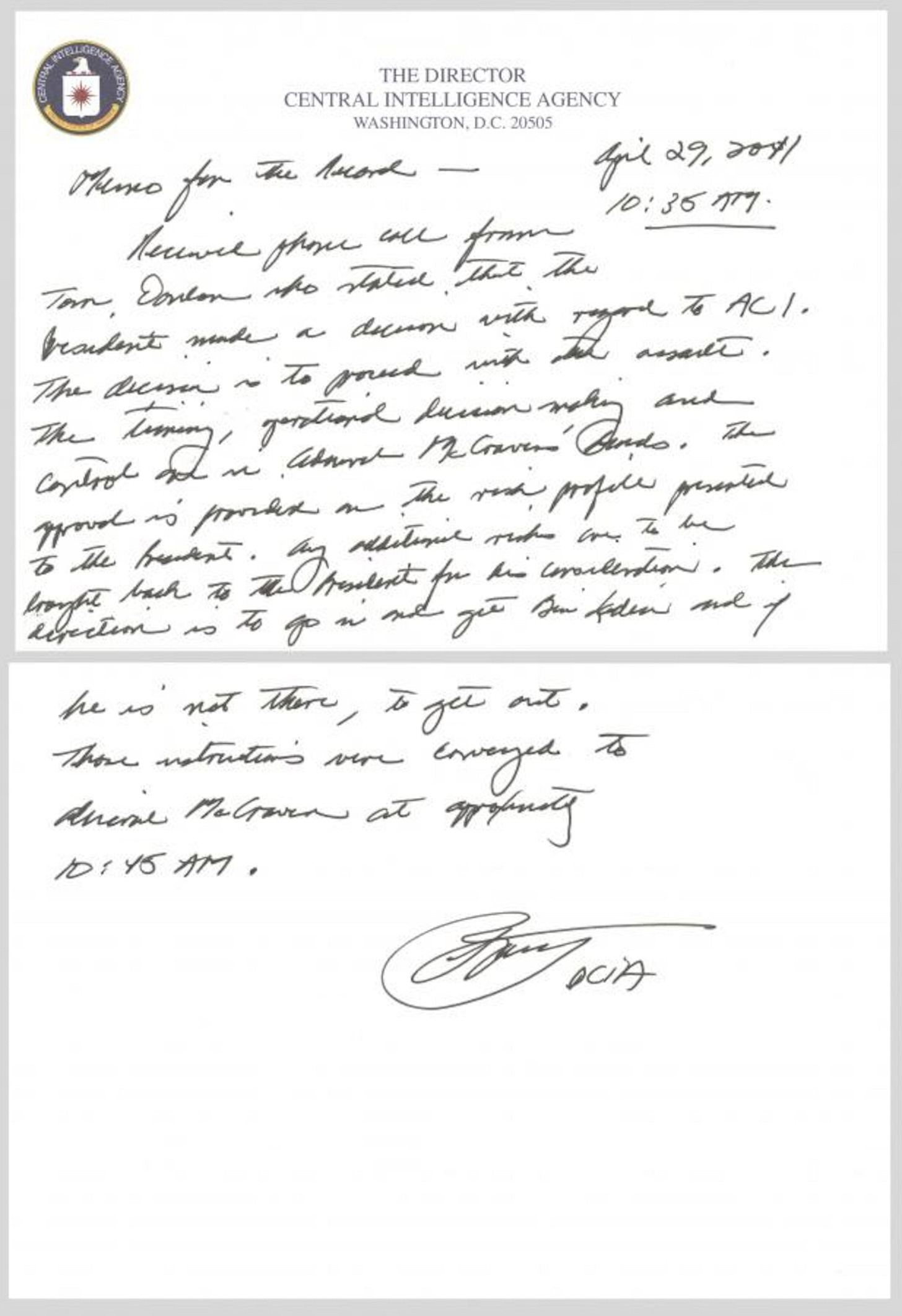
Critical Helicopter Crash
The operation faced a critical setback when one of the Black Hawks crashed due to vortex ring state (VRS) within the compound walls, causing injuries to several personnel onboard. The operators understood the mission's strict time on target (ToT) constraints — as their arrival would inevitably alert the entire town. Following the crash, the team destroyed the downed helicopter's cockpit with concussion grenades to protect sensitive communications and navigational equipment, a process that created multiple explosions and visible flames. Two support Chinook helicopters, allegedly stationed at a nearby Pakistani facility, stood ready for contingencies, with one immediately dispatched to Abbottabad after the crash. However, this replacement helicopter required time-consuming reconfiguration from its fuel transport setup (bladder configuration) to a troop carrier.
No Body, No Crime
Usama's body could not undergo terrestrial interment due to risks of subsequent exhumation and to prevent a martyrs shrine. However, no photographic, videographic, or credible eyewitness testimony exists corroborating the official narrative that UBL's remains were transported intact to an American military airfield in Jalalabad, Afghanistan, followed by immediate transfer to the USS Carl Vinson, a supercarrier conducting routine maritime security operations in the North Arabian Sea, where disposal allegedly occurred consistent with Islamic law. While the body was extracted from the compound, competing after-action reports contained significant discrepancies regarding whether bin Laden's remains—partial or complete—successfully transferred to Afghan territory , with some operational accounts indicating body components were disposed over mountainous terrain during the 90-minute exfiltration flight to Afghanistan. Analysis suggests the maritime burial narrative represents deliberate post-operation fabrication designed to obscure actual disposition circumstances.
Intelligence Harvest
The SEALS' primary mission wasn't targeting a supposed al-Qaida command center, contrary to subsequent White House media briefings. The operators weren't deployed as intelligence specialists to extract comprehensive information— the purpose was to eliminate UBL and intelligence collection served primarily to confirm positive target identification (PID). A multi-phase public disclosure of materials commenced May 20, 2015, via the Office of the Director of National Intelligence; however, this revealed limited direct evidence indicating UBL's ongoing strategic, tactical or operational leadership of al-Qaeda likely due to UBL’s severely deteriorated health. Nevertheless, the compound search yielded significant intelligence cache including: 10 cellular devices, 5-10 computer systems, 12 hard drives, and 100 digital storage media containing 470,000 files, plus handwritten documentation, three Kalashnikov rifles and two pistols were recovered, opium, and personal effects (hair dye etc).
Front-Running the Narrative
On May 1, 2011, following the U.S. Navy SEAL raid that resulted in Usama bin Laden’s death in Abbottabad, Pakistan, the Obama administration rapidly assembled a public narrative to preempt potential leaks, particularly due to the compromised stealth helicopter that crashed during the operation. President Obama delivered an impromptu address hours after the mission, stating that the discovery of bin Laden’s location stemmed from “a possible lead” identified in August 2010, which many within the intelligence community interpreted as referencing a specific informant event, such as the alleged walk-in source. Subsequently, the administration promoted a cover story emphasizing the role of CIA analysts in uncovering a courier network facilitating bin Laden’s communications, thereby attributing the breakthrough to analytical efforts to protect the source. In his speech, President Obama also acknowledged Pakistan’s counterterrorism cooperation, suggesting it contributed to locating bin Laden’s compound, while simultaneously conveying uncertainty about bin Laden’s exact presence there. These statements initiated a complex information campaign aimed at controlling the narrative, balancing the need to protect intelligence sources and methods with the political imperative to highlight the administration’s counterterrorism achievements.
Intelligence Analysis
Subsequent analysis of Bin Laden’s personal journal and over 18,000 document files, approximately 79,000 audio and image files, and more than 10,000 video files the data does not support the coordinated command and control architecture. While bin Laden remained a symbolic leader, Informally referred to as the “father of jihad,” the documents themselves reveal a weakened and operationally impotent al Qaeda, incapable of staging major international attacks with bin Laden frustrated by lack of coordination and affiliate independence. It seems likely that bin Laden maintained some communication and influence, but the direct evidence leans toward a fragmented organization where his control was not absolute or effective, especially over regional affiliates. There is no evidence linking al Qaeda to the 2004 Madrid bombings or the 2005 London bombings, the only post-9/11 attack al Qaeda directed was in Mombasa, Kenya, in November 2002, which killed 13 people, but this was planned prior to 9/11. The documents show tensions with al Qaeda in Iraq, which became the Islamic State of Iraq by 2007, leading to a cutoff in communication. Suffice it to say, all direct evidence indicates Bin Laden’s control over regional affiliates was limited and often strained.
DNA EVIDENCE
DNA samples were collected from bin Laden’s body during the raid, specifically bone marrow and swabs taken by a military medic. These were compared to a comprehensive DNA profile derived from his extended family, including his sister who had died of brain cancer, ensuring a robust match. Official reports, stated the DNA evidence provided a match with a probability of mistaken identity approximately one in 11.8 quadrillion.
Burn After Reading
Following the May raid measures were implemented to restrict access to operational records and eliminate physical evidence. Admiral William McRaven directed that all military records related to the raid be transferred to the Central Intelligence Agency (CIA), thereby placing them under the CIA’s “operational files” exemption, which is not subject to the Freedom of Information Act (FOIA) and limits public disclosure. This transfer circumvented standard federal records procedures, as the National Archives and Records Administration was not notified, and the CIA and U.S. Special Operations Command are separate executive departments. Additionally, McRaven instructed that any photographs of bin Laden’s remains be either turned over to the CIA or destroyed immediately. In February 2012, Pakistani authorities demolished the Abbottabad compound to prevent it from becoming a site of pilgrimage or memorialization, thereby removing potential physical evidence associated with bin Laden’s presence.
Violating Pakistan’s Airspace
Despite public denials, multiple reports suggest senior Pakistani military officials, including Generals Ashfaq Kayani and Ahmed Shuja Pasha, were aware in advance of the U.S. raid on Usama bin Laden’s Abbottabad compound. The original plan allegedly involved Pakistani consent for a covert mission later attributed to a drone strike to preserve plausible deniability and avoid domestic embarrassment. This fits within a broader pattern of quiet CIA use of Pakistani airspace and facilities:
Damadola Strike (2006): Targeted al-Zawahiri; killed 18 civilians.
Datta Khel Strike (2011): Killed 44, sparking widespread condemnation.
Akhtar Mansour (2016): Taliban leader killed in Balochistan, with Pakistan notified only afterward.
Additionally, Pakistan has a history of cooperation in the U.S. rendition program:
Abu Zubaydah: Captured in 2002; severely wounded and transferred to CIA custody.
Binyam Mohamed: Detained in 2002; allegedly tortured before arriving at Guantánamo.
Ghairat Baheer: Held in CIA’s Salt Pit after his 2002 capture in Islamabad.
Conversely, the notion that two U.S. helicopters could enter in Pakistani airspace for 3.6 hours near the capital and major military installations without detection or military response is widely doubted. Officials later claimed any direct engagement risked a larger military conflict and might reveal Pakistan’s potential harboring of bin Laden. Choosing strategic silence allowed Pakistan to avoid both war and public shame.
Quid-Pro-Quo Cooperation
U.S. officials reportedly secured Pakistani cooperation in return for financial incentives (continued military aid) and guarantees of plausible deniability. While the U.S. claimed sole credit for political gain, Pakistan aimed to obscure its role to avoid domestic backlash. Off-the-books Pentagon contingency funds allegedly covered personal incentives and security upgrades for ISI leadership. The transactional nature of this cooperation exemplified a “carrot-and-stick” approach to ensure smooth operation execution.
Analysts often err in treating Pakistan’s security apparatus as a single unified entity. In reality, it was — and is — fractured, with elements simultaneously fighting and supporting militants. After the U.S.-led invasion of Afghanistan in 2001, numerous reports indicated that the ISI offered sanctuary to senior Taliban leaders, for example:
Mullah Omar, the Taliban’s reclusive leader, was reportedly sheltered in an ISI safe house in Quetta before being moved to other cities like Karachi, Islamabad, and Lahore to evade U.S. detection.
Beyond providing sanctuary, the ISI has been accused of offering operational support to the Taliban: Including training camps for Taliban recruits near Quetta, supplying them with equipment, logistical assistance as well as providing wounded Taliban insurgents with medical treatment.
The Safe house
The Inter-Services Intelligence (ISI) maintained a network of safe houses across secure, residential areas in Pakistan used for various covert purposes including interrogation, house arrest, and protective custody. These facilities offered varying levels of autonomy, with some detainees guarded and others operating with greater freedom. According to some sources a compartmentalized unit within the ISI allegedly managed Usama bin Laden passively in this manner. Former ISI officials and leaked emails indicate that up to 12 ISI and military officials were aware of bin Laden’s Abbottabad compound. This allowed the agency to maintain plausible deniability, deliberately preventing active investigations into the compound. Leaked diplomatic cables and reports from American diplomats noted that Pakistani security services were tipping off militants, including bin Laden, ahead of U.S. operations, particularly in North Waziristan. These actions prevented successful raids and maintained bin Laden’s operational security.Reports suggest this special desk operated with strict secrecy, known only to a select group of mid-to-senior level ISI officers and at least one retired military official. However, some sources identify Brigadier (Ret.) Ijaz Shah, former head of the Intelligence Bureau (2004–2008), as instrumental in arranging bin Laden’s stay, possibly with the tacit approval of then-President Pervez Musharraf and General Ashfaq Pervez Kayani.
Bin Laden was reportedly considered a strategic asset—a “Golden Goose”—by Pakistan’s military establishment. He was seen as potential leverage to extract political concessions or financial aid, particularly from the U.S., at an opportune moment; as well as influence Taliban and al-Qaida activities in the region. For example, during his time in hiding, bin Laden maintained correspondence with militant leaders such as Hafiz Muhammad Saeed (Lashkar-e-Taiba) and Mullah Omar (Taliban), both of whom were aligned with Pakistan’s strategic goals and had known ISI ties. Notably, in 2007, bin Laden’s approval rating in Pakistan stood at 46%, surpassing that of then-President Pervez Musharraf at 38%; while support among Pakistanis declined significantly over the years, with only 21% expressing confidence in him by 2011, a majority (63%) disapproved of the U.S. military operation that led to his death, and 55% viewed his killing as a negative event. These factors likely influenced the decision to periodically check on him while allowing him to remain undisturbed at the compound.
Retired General Asad Durrani, former ISI chief, publicly stated in 2015 that it was plausible senior ISI officials were aware of bin Laden’s location, implying a quid pro quo arrangement. He emphasized that: “if you have someone like Usama bin Laden, you are not going to simply hand him over to the United States.”
Saudi Arabia’s Role
Reports allege that Saudi elements provided financial support to Pakistan to conceal bin Laden, driven by shared religious and political interests — and a desire to prevent his interrogation by the U.S., which could expose Saudi links to al-Qaeda. This funding purportedly helped cover bin Laden’s living expenses and security.
Deny, Disclaim, Disavow
Pakistani officials have consistently denied prior knowledge of Osama bin Laden’s presence in Abbottabad. The United States deliberately excluded Pakistan from the raid planning, citing concerns over potential intelligence leaks. The Abbottabad Commission, established by the Pakistani government to investigate the circumstances surrounding bin Laden’s prolonged presence and the U.S. operation, concluded that his ability to reside undetected for nearly a decade was due to “collective failure” and “routine” incompetence across various levels of civil governance. The report criticized both the government and military for “gross incompetence” and “dereliction of duty,” finding no concrete evidence of ISI complicity. The Commission introduced the term “Governance Implosion Syndrome” to describe the systemic negligence observed across civilian, military, and intelligence agencies. Notably, the ISI had previously captured high-value targets, such as Umar Patek, near Abbottabad but failed to connect these operations to bin Laden’s presence. Local officials also overlooked the compound’s lack of utilities, unpaid taxes, and unauthorized construction over six years. One critique highlighted that Pakistani intelligence functioned as “little more than a post office.” Following the incident, ISI Chief Gen. Shuja Pasha met with CIA officials to defend the agency’s lack of awareness, attributing it to “imperfect intelligence.” Islamabad has consistently rejected allegations of state complicity; former President Musharraf referred to bin Laden’s presence as a “blunder,” while the Foreign Office dismissed claims of cooperation as “baseless speculation.”
Mullen Memo Controversy
In the aftermath of Osama bin Laden’s killing in Abbottabad on May 2, 2011, Pakistan’s civilian leadership faced intense scrutiny and pressure from the military establishment. Amid fears of a potential military coup, a confidential memorandum—later dubbed the “Memogate” scandal—was allegedly drafted by Pakistan’s then-Ambassador to the United States, Husain Haqqani, at the behest of President Asif Ali Zardari. The memo, delivered to U.S. Admiral Michael Mullen via Pakistani-American businessman Mansoor Ijaz, sought U.S. assistance to preempt a military takeover and proposed significant overhauls in Pakistan’s national security apparatus. The memorandum outlined a plan to replace key military and intelligence officials, sever ties with militant groups, and grant the U.S. broader operational freedom within Pakistan. It also promised to bring transparency to Pakistan’s nuclear program and to cooperate with India in prosecuting those responsible for the 2008 Mumbai attacks.
Conclusion
The success of Operation Neptune Spear relied on integrating HUMINT (e.g., courier tracking, walk-in sources), SIGINT (call intercepts), and GEOINT (satellite/drone surveillance). Despite official accounts, while enhanced interrogation techniques (EITs) provided partial leads, critical intelligence likely emerged from retired Pakistani brigadier’s tip. Evidence suggests elements within Pakistan’s ISI provided sanctuary to UBL from 2002–2011. The compound’s proximity to military infrastructure, lack of official investigation, and alleged ISI coordination with Saudi financiers indicate institutional awareness, despite public denials. he mission’s near-compromise due to a helicopter crash forced rapid narrative adjustments, exposing operational vulnerabilities. Post-raid efforts to obscure UBL’s body disposition and restrict records (via CIA exemptions) aimed to mitigate political and security fallout. Recovered materials confirmed UBL’s symbolic leadership but operational irrelevance, revealing al-Qaeda’s fragmentation. The U.S. prioritized elimination and PID for a clear political victory. The U.S. bypassed Pakistani authorities to prevent leaks, reflecting deep mistrust. Post-operation, Pakistan’s “collective failure” narrative and internal crises (e.g., Memogate) highlighted systemic governance flaws and military-civilian tensions.
End of Brief.
[For more information on Section 14 please click here.]




